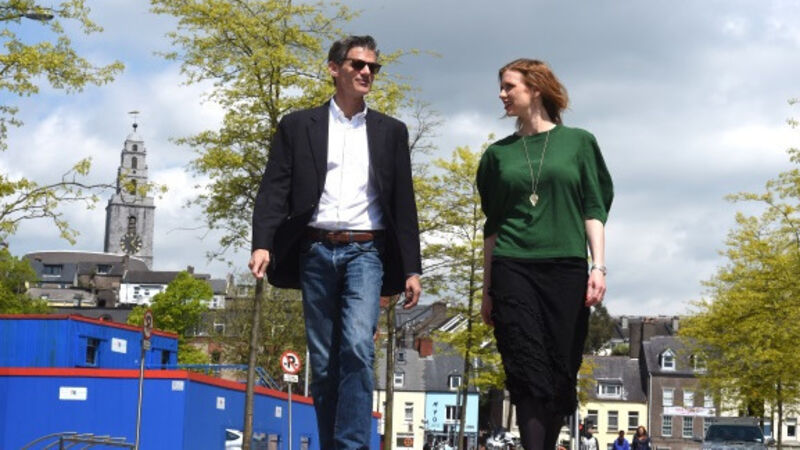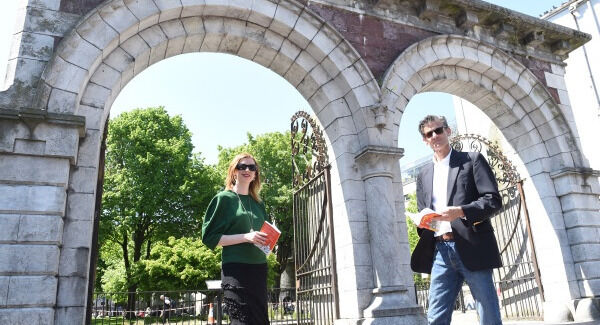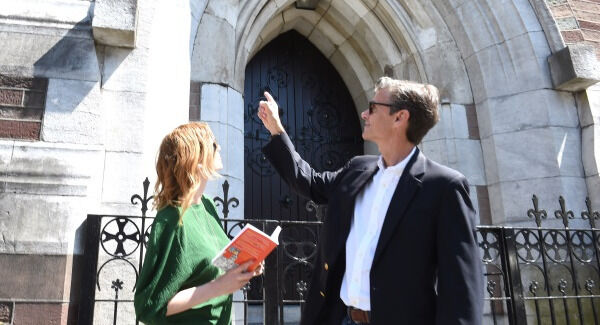Cork Strolls shares fascinating facts about the city and county

From history to architecture, discovers a new side to Cork as she embarks on a guided tour with the authors of a new book on the city
The sun gods are smiling down on us and Cork has never looked better as I stroll towards the city’s historic Coal Quay to meet Greg and Audrey Bracken.
Though I’m not a native, I’ve lived in Cork for more than two decades; I’ve walked its streets countless times and didn’t think there was much left for me to learn about my adopted home.
That, though, was before I met the Brackens, the brother and sister team behind the book Cork Strolls: Exploring Cork’s Architectural Treasures.
The beautifully produced publication features a collection of zoned mapped walks of varying lengths, stretching from Shandon to UCC. There are also sections on areas further afield, including Cobh and Kinsale.

The book is unusual in that it doesn’t feature photos, but rather exquisite, hand-drawn illustrations by Greg, an architect, who lectures in urbanism at the University of Delft in the Netherlands.
The trails are accompanied by fascinating facts researched by Audrey, who previously worked in publishing and lived in Kinsale for a period before moving to Dublin, where she now works for the Smurfit School of Business.
The Cork Strolls book is the latest in a long series produced by Greg and Audrey.
“Greg started doing it in Asia when he was based over there for years, in Bangkok and Singapore. I was living in New York and we decided to collaborate on a book on Kuala Lumpur, because I had been out there with Greg a few years before that on holidays,” says Audrey.
“When I returned to Ireland, we decided to do a Dublin book. We looked for an Irish publisher and Collins Press were delighted with the idea after seeing the other books we had done. Dublin Strolls came out in 2016 and it ended up being a best-seller. We were delighted. In the meantime, we had started working on Cork, because each one is about two years in gestation.
It’s a lovely project, it brings us closer and it’s great fun.
Greg did his first book when he lived in Singapore more than 20 years ago.
“They only had these big, fat guidebooks and nothing about the architecture, so I made my own little guide. It has the artist’s sketchbook feel, along with information about the architecture. We were lucky enough to get Collins Press to do the Dublin one. They are such lovely publishers to work with. They wanted to do more Irish cities, and we knew Cork. It is such a beautiful city that we were delighted to do it,” he says.
I meet Greg and Audrey outside the charming Dennehy’s pub; we are in the shadow of Shandon, one of Cork’s best-known landmarks. Also, just across the River Lee, is one of Greg’s favourite buildings in the city, St Mary’s church, one of the first Catholic places of worship built in the city after Emancipation.
“It’s a stunning building; to think it was designed by a Protestant architect [Kearns Deane], for free, for Catholics,” laughs Greg. “They had planned these hideous towers, which didn’t get built, because the architect died of TB and his brother took over.”
While St Fin Barre’s draws the most admiration, Greg favours St Mary’s.
“St Fin Barre’s is Gothic and it’s exquisite, but this is my favourite. I like classical architecture, it’s so organised.”
Across from us, on North Main Street, can be glimpsed St Peter’s, a Gothic church, which is now an arts centre. Greg regales us with a ghoulish story attached to this building.
“A man called Francis Taylor was buried here in 1753, but he was found the next morning sitting on top of his grave with his shroud torn to pieces; he had managed to break out of his coffin and claw his way out through the clay.”

Further up the Coal Quay is the building that housed St Peter’s Market.
“The English Market was the Protestant market,” says Audrey. “St Peter’s Market was known as the Irish Market, because all the country people would come in and sell their wares there. It was also nicknamed Paddy’s Market. It was more affordable for the locals, which is why they tended to go there.”
We walk up to Paul Street, which is buzzing with activity, with people strolling and a busker singing. I’m surprised to hear it was once the equivalent of Cork’s red light district.
“This was where the local craftsmen had their homes; the plumbers, the tinsmiths, the shoemakers,” says Audrey. “There were also a number of taverns and brothels for the sailors, because Kings Dock is where Emmet Place is now. It became tenements after that and was rebuilt in the 1930s.”
Here, we pause by Ss Peter and Paul’s Church, which, as well as having several interesting architectural features, also has a particularly fascinating back story.
“Interestingly, Catholic emancipation only took place in 1829, but they were building Catholic churches in Cork in the 1760s... They were much more tolerant here, and Catholics and Protestants co-existed far more happily,” says Greg. “It’s a very fine example of Gothic architecture. You can usually tell, because it’s got the pointed arches and buttresses, and that lovely red sandstone which is typical of Cork, with a nice limestone and granite trim.
They didn’t quite finish it. You can see the niche up there that should have a statue in it, but they ran out of money. This should have had a tall spire on it, but they couldn’t afford it, so they just put a little roof on it.
The church was built due to the efforts of Fr John Murphy, whose life story sounds like something from a Hollywood movie.
“He was from a well-to-do local Protestant family and his nephew founded Murphy’s brewery,” says Audrey. “He was sent to school in England. From there, he joined the East India Company and then the Hudson Bay Company in Canada. He came back to London briefly and set up a business with his brothers and it didn’t go very well. Back he went to Canada, where he joined a local tribe of Native Americans, lived with them for 12 years, eventually became their chief and earned the name The Black Eagle of the North.
“One day he was in the woods, bumped into a French priest who asked him for some flour to make some communion bread. He returned to the spot to find a statue of the Virgin Mary erected by French Canadian settlers; he took this as a sign, not only to convert to Catholicism, but to go to Rome to be ordained as a priest. He then returned to Ireland and set about fundraising in 1844 and this church is the result; it was built in 1869.”

We turn onto St Patrick’s Street, which a few centuries ago would have been navigated by boat.
“It was originally a waterway, which explains why it is so curved, wide and generous,” says Greg.
Steps for reaching first-floor offices over what were once waterside storehouses can still be seen at the corner of Academy St.
As we walk down Grand Parade, by the corner of Washington Street, Greg dispenses another surprising fact: That while the city of Waterford is synonymous with glass production in Ireland, Cork was a hub of glass production in the 18th century, before high tariffs imposed by the English and industrial action closed the factories.
We finish our ambling at Nano Nagle Bridge, the National Monument on one side, the spires of St Fin Barre’s visible on the other. Greg says the Protestant church is an underrated masterpiece. He also points out that the cathedral organ was moved from over the central entrance to beneath the chancel floor, making it the only underground church organ in the world.
For Audrey, the church reflects how Catholic and Protestant cultures co-existed harmoniously.
“It is really interesting, the way the Catholics and Protestants lived here together in a kind of an easy juxtaposition. It was different from Dublin, where the Catholic churches were kept down little side streets.
Here, it was more open and tolerant, you can see it’s the people of Cork who had this lovely, easy disposition which has translated into the urban planning.
Greg is optimistic about Cork’s architectural future.
“The Glucksman in UCC is magnificent and the Nano Nagle Place complex is extremely well done. We shouldn’t be afraid of modern buildings. You don’t have to copy an old style, you just have to understand what made it work, how it was used, the material used, the scale. Don’t just demolish either, see how can you reuse.”
We have only scratched the surface of the fascinating stories that lie behind the buildings of Cork, but the book has highlighted the importance of really looking, not just seeing.
“A city reflects the people who live in it,” says Greg.
As I stand on the bridge, with the majestic sweep of Grand Parade on one side, the elegance of South Mall on the other, the rush of the river at my back; people sitting in the sun, chatting, drinking coffee, enjoying their city, I couldn’t agree more.
Cork Strolls: Exploring Cork’s Architectural Treasures, Gregory and Audrey Bracken, Collins Press, €12.99










